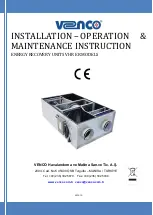
18
|
Piping installation
Installer and user reference guide
100
REMA5+REYA8~20A7Y1B
VRV 5 heat recovery
4P687640-1 – 2022.07
Method 2: After power ON
If the system has already been powered on, activate setting [2‑21] (refer to
"21.1.4 To access mode 1 or 2"
130]). This setting will open field expansion
valves to guarantee a refrigerant piping pathway and make it possible to perform
the leak test and the vacuum drying.
DANGER: RISK OF ELECTROCUTION
NOTICE
Make sure that all indoor units and BS units connected to the outdoor unit are
powered on.
NOTICE
Wait to apply setting [2‑21] until the outdoor unit has finished the initialisation.
Leak test and vacuum drying
Checking the refrigerant piping involves:
▪
Checking for any leakages in the refrigerant piping.
▪
Performing vacuum drying to remove all moisture, air or nitrogen in the
refrigerant piping.
If there is a possibility of moisture being present in the refrigerant piping (for
example, water may have entered the piping), first carry out the vacuum drying
procedure below until all moisture has been removed.
All piping inside the unit has been factory tested for leaks.
Only field installed refrigerant piping needs to be checked. Therefore, make sure
that all the outdoor unit stop valves are firmly closed before performing leak test
or vacuum drying.
NOTICE
Make sure that all (field supplied) field piping valves are OPEN (not outdoor unit stop
valves!) before you start leak test and vacuuming.
For more information on the state of the valves, refer to
101].
18.3.2 Checking refrigerant piping: General guidelines
Connect the vacuum pump through a manifold to the service port of all stop valves
to increase efficiency (refer to
"18.3.3 Checking refrigerant piping: Setup"
101]).
NOTICE
Use a 2-stage vacuum pump with a non-return valve or a solenoid valve that can
evacuate to a gauge pressure of –100.7 kPa (−1.007 bar)(5 Torr absolute).
NOTICE
Make sure the pump oil does not flow oppositely into the system while the pump is
not working.
















































